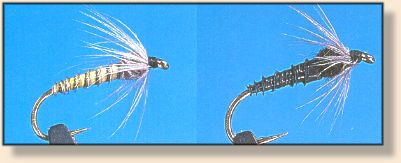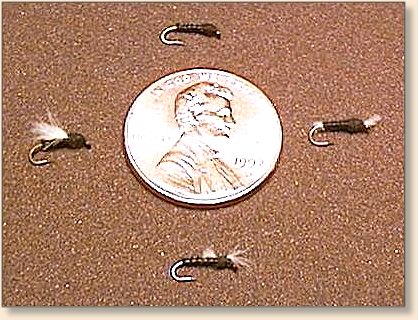|
Biot Midges
This week's fly is really an easy-to-tie family of
flies that imitate different forms of the
same insect. It shows how you can add a single material
in strategic places and come up with something that
just might match whatever the fish are taking at the time.
Maybe it will give you an edge.
Except for a few places that close to protect
native cutthroat populations, there is no
closed season for trout fishing in Colorado.
That means we fish midges a lot, because
there really isn't much else happening during
the winter. During the first week of January
this year, a friend and I got cabin fever pretty
bad and decided we needed to go fishing.
He took me to a place I had never fished before.
Not a GREAT place, mind you, the water
was pretty murky and there were other fishermen
on the water, but in January at this
elevation you are happy just to find liquid water.
When we got there, the afternoon midge hatch had
started and there were dozens of fish
rising below every riffle. Small rainbows, 8-14
inches, escapees from a nearby hatchery
who grew up in the stream, but we all know there
are no BAD fish. We knew they had
to be taking midges, and deduced they had to be
taking emergers for a number of reasons.
We fished everything we had: Palominos, WD-40s,
RS-2s, anything that we thought would
work. After several hours, he had two fish
and I had one. Clearly, we weren't throwing
something that interested these fish. After
another trip down to the same spot with similar
results, I brought my trusty 50 cent aquarium
net, waded into a riffle, spooked all the fish,
and figured out what they were eating. Tiny
little black midges, size 24. I saw empty shucks,
I saw pupae, I saw emergers. Whole rafts of them.
The fish were just slurping them off the
surface. When I went home that night, I decided
to tie up something that looked like what I saw.
Any good "match the hatch" book will have a picture
of a midge pupa, probably taken through a microscope
so you can see the head, thorax, wing pads, maybe even count
the body segments. The best way to use one of these
pictures is to hang it on the wall and look at it
from across the room, because what the fish sees
is going to be less than a quarter inch long and
silhouetted against the sky, and he'll have to
react to it within a second or two or it will be
past him in the current. If trout are taking midges, they will
usually take anything that looks almost right and
spit it out if it turns out to be inedible.
The most important thing in imitating something
this small is to focus on the basics: size,
color, profile. From across the room, your midge
picture is going to show you that your
midge needs to have a skinny little segmented
abdomen, a beefy thorax that you can't
really tell from the head, and not much else.
Look at midges in the water from about 3
feet away where the fish first react to them
and you'll see the same features.
What I tied that night was a basic biot midge.
It has a skinny, segmented body; a thorax
that's between 1/4 and 1/3 of the total length
of the body; and not much else. I tied black
ones in size 22 and 24, then went fishing. I
started getting strikes on every other cast.
Figure 1 shows the basic version of this fly and
three variations I cooked up because we
don't have enough else to do around here in the
winter. Also, because the water is clear
some days and you can sometimes see the gills
on the midges. All are pictured at size 20.
Clockwise from the top, there's the Basic Biot
Midge, a pupal form that has gill tufts fore
and aft, an emerger form that has the remnant
of a gill tuft in the front and a stubby emerger
wing, and an adult form that has a wing that
imitates the body-length delta wing of an adult
midge. They are all tied about the same way.
The basic midge is extremely simple to tie;
the variations add only one more material, CDC.
None of these flies are "new" and I claim
credit for none of them. Since tying them, I
have seen similar flies in a lot of books.
But then we all know there are no new flies.
Materials
Hook: Dry fly hook, 18-26 (flies pictured are size 20).
Thread: To match biot and natural.
Abdomen: Goose or turkey biot, black,
gray, brown, olive, tan or red, to match natural.
Thorax: Superfine dubbing to match biot or tying thread.
Gills or wings: White or light dun CDC puff (see tying
instructions).
Tying Steps:

1. If you are tying the basic, emerger, or adult form, start the thread
just behind the eye and wrap a thread base to the zero point of the hook.

1a. If you are tying the pupal form, tie on about a quarter of a puff of
CDC right where you started the thread so that the tips extend about two or three
eyewidths forward of the eye of the hook. Wrap it down as you wrap the thread base,
then tear or clip the butts one or two eyewidths rear of the zero point. You have
just formed both gill tufts.

2. Tie on and wrap a biot body of the desired color as explained in this week's
Tying Tips. Wrap it as far forward
as you can without crowding the eye, tie it off, and clip the butt. If you're tying
the basic form, skip to Step 4.

3a. If you are tying the emerger form, tie on about a quarter of a puff of CDC where you finished the biot so that that the tips extend about two or three eyewidths forward of the eye of the hook. Wrap it down with three or four thread wraps, and clip or tear the butts at mid-body. You have formed the gill tuft and emerger wing.

3b. If you are tying the adult form, tie on
a generous amount of CDC (about half a puff) where
you finished the biot. The tips should project
rearward to mid-bend of the hook. Clip the butts
flush with the tying thread. You have just formed the wing.
When it's wet, it will lay down in the film and look
just like the delta wing of an adult midge.

4. Form a thorax with a small amount of
dubbing or with your tying thread. If you
choose to use dubbing, use only a few strands
of superfine, just enough to see on the
thread, twist it on tightly, and dub only about
an inch of the thread. The choice of dubbing
or tying thread is up to you. Some people dub
faster than they wrap thread. The objectives
are to make the front 1/4 or 1/3 of the body
about twice the diameter of the rest of the fly
and to cover up the places you tied off the biots
and tied in the other materials.
5. Whip finish, clip the thread, and you're done.
More on Biot Midges:
I chose a dry fly hook for these flies for a couple
of reasons. First, I've spent a lot of time watching
midges. Most species (not all, but most) emerge in
the film parallel to the surface of the water, so
I wanted a straight shank. Second, since I was
planning to fish this fly in the film, I wanted light wire.

Roy Palm of Roaring Fork Anglers ties a very effective
biot midge emerger (above) that uses the same theme, but he
finishes off the Basic Midge with a sparse wrap of hen feather at
the front. I've fished it, it works. When I tie
it I use starling.
Each of these flies is totally impossible to see
in the water and fish take them gently, so some
sort of strike indicator is necessary. I fish
them when the fish are looking up - i.e., when
some sort of rises are evident. I fish them on
about a foot and a half of 6x or 7x tippet tied
to the bend of an ugly, high-floating dry fly
that I can see (think Humpy, Wulff, Stimulator here).
I grease the entire length of the tippet to keep the
fly in the film.
I have to confess that although I have fished and
caught fish on all of the forms presented above,
I've fished the Basic pattern most often. It
has all the essentials: size, color, profile.
If you use tying thread for the thorax, there's
only one material - the biot. Although I'm not
a guide, I'd have to call it a Guide Fly: catches fish, cheap, and
you can tie two dozen of them an hour even after a beer or two.
Tie some up in different colors and sizes. When
you see midges on the water, try them.
You might like them. Let me know if they work
as well for you as they do for me.
~ Ralph D'Andrea
Sources Used:
Best, A.K. (1989): Production Fly Tying. pp 67-68.
Best, A.K. (Date unknown): Biot Miracle Nymph.
http://www.flyshop.com/scripts/Flies/details.cfm?ID=1916&flyname=Biot%20Mira
cle%20Nymph
Lesson, Ted, and Jim Schollmeyer (1999): The Fly Tier's Benchside
Reference. pp 112-114
Mason, Harry (2000): Tying with Biots.
http://www.flyshop.com/bench/features/12-00biot/
For more great flies, check out:
Beginning Fly Tying,
Intermediate Fly Tying and Advanced
Fly Tying.
|








